Cody sports some SSD morale while on duty.
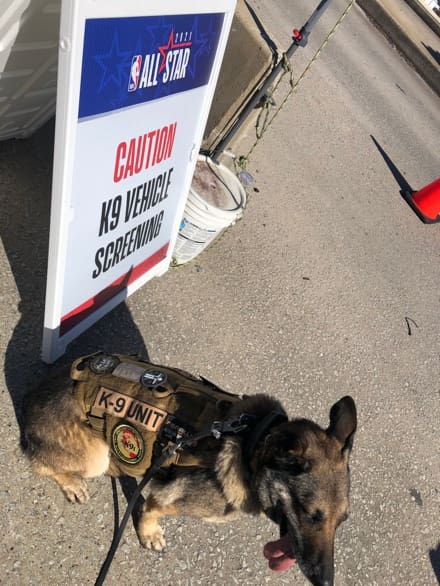
Stay safe!
Cody sports some SSD morale while on duty.

Stay safe!
JOINT BASE SAN ANTONIO-LACKLAND, Texas (AFNS) —
The Air Force Security Forces Center’s vehicle program delivered the first of new military working dog patrol vehicles to Robins Air Force Base, Georgia, as part of their initiative to modernize Defender equipment across the Air Force.
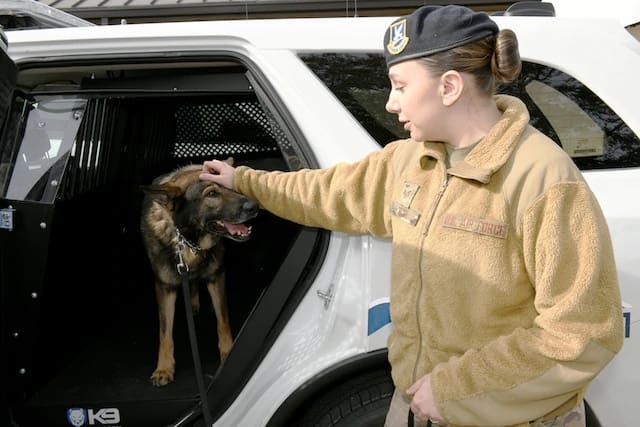
The improvements from previous patrol vehicles is the result of AFSFC’s vehicle program’s input to the Federal Service Law Enforcement Vehicle Equipment Standardization initiative and is focused on keeping MWD handlers and canines mission-ready.
Security Forces members at Robins learned about the vehicle “hot dog” system, which automatically kicks in when the interior gets too hot for the canines. The full-size sport utility vehicles also have a more spacious interior that gives the dogs a more comfortable ride.
“These new vehicles are definitely an upgrade,” said Staff. Sgt. Matthew Cerulli, MWD handler with the 78th Security Forces Squadron. “I think the best thing is the ‘hot dog’ system, which, in case of an emergency, we have to leave our dog in the vehicle and it gets too hot, an alarm will go off, the windows will roll down and the A/C will crank on to help keep the canines cool.
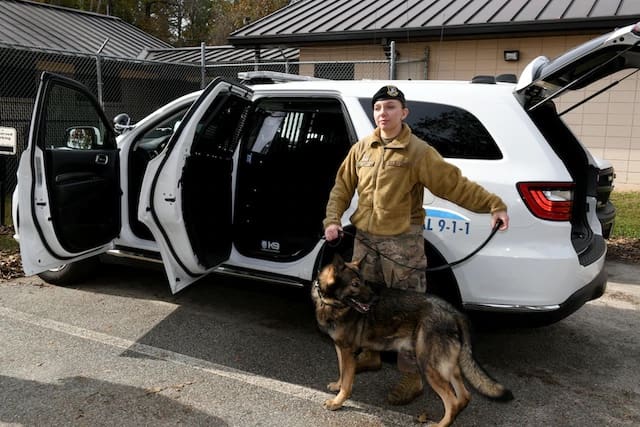
“However, I think the dogs’ favorite thing is the additional room. We have some large canines and in this new vehicle they can get up and stretch out as needed,” Cerulli added.
“AFSFC’s Vehicle Program seeks efficiencies in vehicle procurement, decreases redundancies and streamlines processes to improve law enforcement readiness,” said Master Sgt. Michael Roth, Security Forces vehicle program manager at AFSFC.
Prior to the FEDSLEVES program, units sourced their own funds to purchase the necessary equipment, which required local vendors to upfit vehicles after they arrived at the installation.
“This program provides security forces units with vehicles that are standardized with pre-installed equipment packages,” Roth said. “We also provide funding for (other) equipment in these vehicles, allowing them to go on patrol immediately. We’re saving the units $17,700 per patrol vehicle and $19,500 per MWD patrol vehicle, so we’re saving the unit both time and money.”
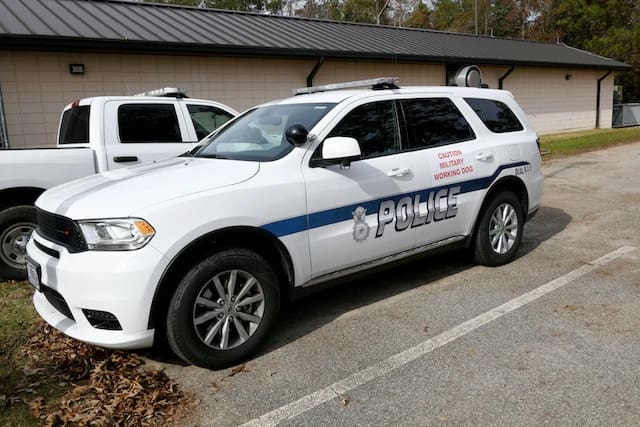
Defenders at Robins AFB and their canines are rolling out in these ready-to-go SUVs.
“These vehicles are a big step forward in keeping our mission ready here at Robins Air Force Base,” said Tech. Sgt. Seth Wilson, 78th SFS kennel master. “Our mission, along with the military working dogs, is to keep everyone on base safe, and these new vehicles allow us to focus more on accomplishing that.”
Additional improvements include a radio prep package, which allows operators to plug and play their current radio systems, an upgraded emergency lighting and public address system, and increased weapons storage in the rear cargo area.
“These new MWD vehicles are a product of the hard work of the Air Force Security Forces Center’s Vehicle Program team to modernize the fleet and keep Defenders and their canines mission ready,” Roth said.
Security Forces units can expect to receive the new vehicles as their current ones reach their end-of-life cycle, Roth added.
Story by Malcolm McClendon, Air Force Installation and Mission Support Center Public Affairs
Photos by Joseph Mather
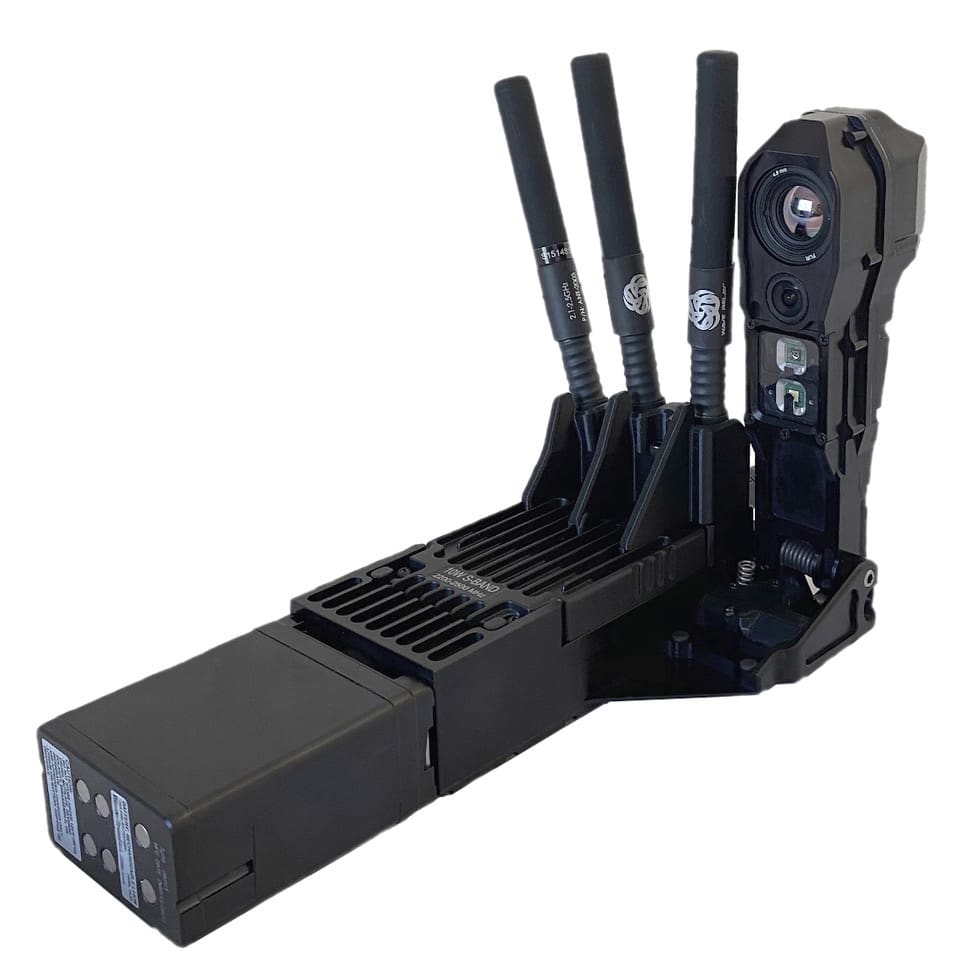
The NEW Ghost K9 Camera (MANET K9 Camera) from Tactical Support Equipment Inc. is housed in a Waterproof Enclosure. The system now incorporates a selectable Color Day/Night Camera or High Resolution Thermal Camera. The Infrared Illuminator is now controlled by the Day/Night camera sensor, so it is able to brighten or dim the Illuminator as required, which saves overall battery life. The Thermal Camera operates at a full frame rate, which produces no lag in video. With selectable White Light and Infrared Strobe Light. The Ghost K9 camera is GPS enabled as well.

The Ghost K9 Camera is viewed and controlled by a K9 Plug-In for the Android Tactical Assault Kit (ATAK), which is run on Android Device. User can view and record video and view K9 Camera and K9 Handler location on a map with ATAK.

The Ghost K9 Camera now operates on the Persistent Systems Wave Relay® Mobile Ad Hoc Networking (MANET) System. The Ghost K9 Camera operates as a part of the Wave Relay® Ecosystem. User can select between 10-Watt L-Band and S-Band Radio Modules. C-Band Radio Modules are also available on request. Security of the link is ensured by Crypto Modes: AES256 Encryption and SHA-256 HMAC.

www.tserecon.com/products/k-9-camera-kit-ghost-mobile-ad-hoc-network-enabled
Author Christine Hassing brings awareness to the level of healing service dogs bring to those living with trauma in ‘Hope Has A Cold Nose’

BLOOMINGDALE, Mich. – Statistics show that twenty-two U.S. military veterans commit suicide per day. This alarming issue inspired author, mentor and inspirational speaker Christine Hassing to learn more about the experiences of veterans suffering with post-traumatic stress disorder (PTSD) and military sexual trauma (MST). She soon discovered the remarkable impact service dogs played in their journey towards healing and recovery. Wanting to share their perspective, she collaborated with twenty-three veterans and compiled their unique stories in her recently published book, “Hope Has A Cold Nose.” This incredible collection of true tales conveys how service dogs make the difference for those reintegrating themselves into civilian life.
While earning her master’s degree, Hassing’s path intersected with a veteran and his service dog. After listening to their story, she knew that she wanted to spotlight the struggles of fellow veterans like him who are healing from trauma with the support of their furry friend. From sensing a nightmare and waking a veteran before terror takes hold, to placing a comforting paw on someone’s shoulder to ward off a panic attack, these dogs provide immeasurable support day and night.
Each chapter shares the story of a different human-canine pair as they explore their life changing relationship. The compelling testimonies from each and every storyteller in the book reminds readers of the importance of compassion and community during the recovery process for veterans.
“It is my hope that the stories within this book can raise awareness about service dogs as a healing modality for those journeying with PTSD,” says Hassing. “and to inspire those who are struggling to not lose their will to live.”
An inspiring read, “Hope Has A Cold Nose” showcases the holistic healing power of canines. Filled with extraordinary stories of resilience, compassion, survival, hope and recovery, this book is an unforgettable look at how animals can help their human counterparts heal from the deepest emotional wounds.
“Hope Has A Cold Nose”
By Christine Hassing
ISBN: 9781982255282 (softcover); 9781982255305 (hardcover); 9781982255299 (electronic)
Available at the Balboa Press Online Bookstore, Amazon and Barnes & Noble
WASHINGTON –- It was a hot and muggy evening at Fort Clayton, Panama, as then-Pfc. Renae Johnson scanned the jungle tree line in an attempt to stop thieves from gaining entry into the installation.

It was 1992, and Johnson was a member of the Missouri National Guard’s 205th Military Police Battalion. Determined to protect and serve, she enlisted just a year prior at age 17, which landed her a short deployment to support local law enforcement efforts with the 534th MP Company.
A career with the Missouri Guard felt like the right path at the time, or at least that was what Johnson thought until that evening, she said.
“That is when I met my first military working dog (MWD) handler coming out of the jungle,” as she crossed paths with then-Staff Sgt. John McKinney and his narcotics detection dog “Solo 503P” out on patrol, she explained.
McKinney was an imposing figure, standing over 6-feet tall with stacked airborne and air assault badges on his uniform, Johnson said. Solo stood idly beside him and appeared just as large and threatening as his handler.
He stuck around to answer all of Johnson’s questions and even suggested she move to active-duty to pursue a career as a MWD handler, she said.
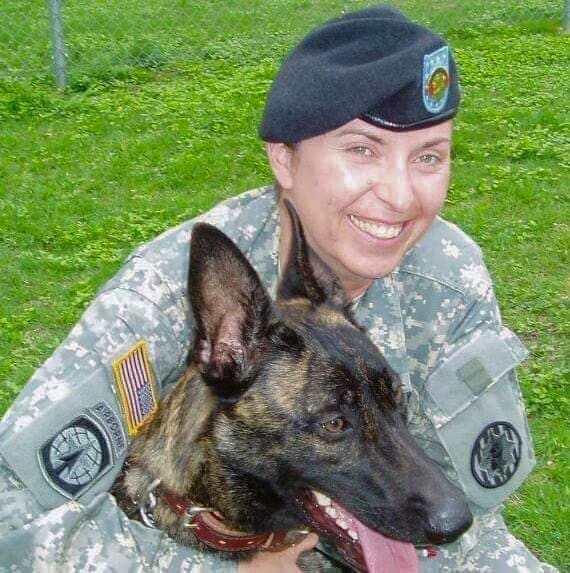
Six months later, she finalized her transition paperwork and moved to active-duty. Johnson would then go on to spend the next seven years, to include multiple deployments and assignments, working toward her goal, she said.
“I just knew it was something I was meant to do,” she said. “Being an MWD handler is an intense and high-impact job — a way of life.”
On Oct. 17, the Military Women’s Memorial unveiled its first monument on the eve of its 23rd anniversary. The memorial honors and tells the stories of women, past and present, who have served the nation.
The monument, titled “The Pledge,” captures a moment of mutual respect and love between a female handler and her Belgian Malinois, said Susan Bahary, its artist.
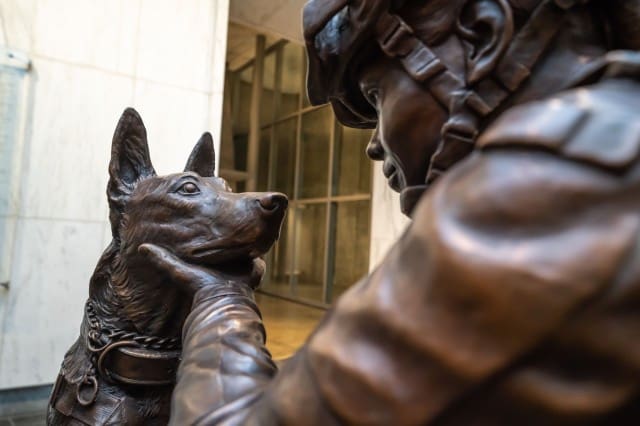
The monument depicts a dog reaching up to her handler as she kneels beside the dog. It captures a feeling of commitment and support, as both reach out to each other with a desire to accomplish their mission, Bahary added.
Johnson proudly served as a handler before retiring in 2012 as a sergeant first class with a military occupational specialty code of 31BZ6, or a MP officer with a working dog additional skill identifier, she said. The Army transitioned to the new 31K MWD handler career field just two years later.
“The job was physically and mentally draining, but none of that mattered if I had my dog beside me,” she said.
As a career handler, Johnson attended the unveiling ceremony with other military handlers. Together, they showed their combined support for their career field and paid respect to the female handlers who helped paved the way, she said.
“It is a beautiful monument that will one day change the trajectory of some little girl’s life,” Johnson said, much like the way her life changed when she first met Solo and McKinney.
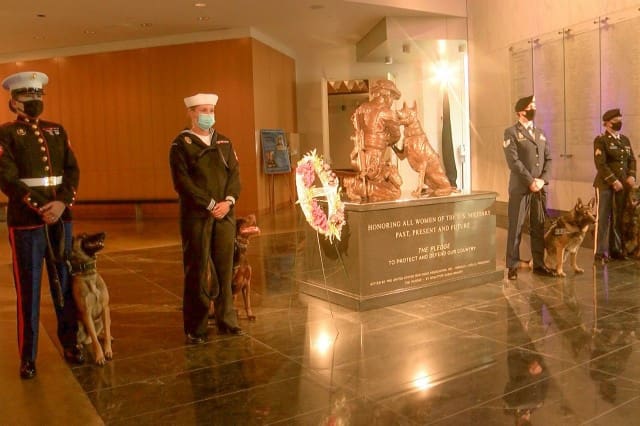
MWD impact
Military working dogs are a force multiplier, often used to provide patrol, narcotics, and explosive detection capabilities in garrison or on the battlefield, said Sgt. Maj. Viridiana Lavalle, the Army’s most senior ranking 31K MWD handler.
These dogs can do “a plethora of things that no piece of equipment or Soldier can emulate … with their sense of hearing, smell and ability to detect,” said Lavalle, who is the provost sergeant major for the directorate of emergency services at Fort Sill, Oklahoma.
Handlers often operate as individual augmentees and can deploy at home or abroad with any unit or agency to provide immediate animal support, she said.
“Dog handlers must be extremely self-sufficient and independent, regardless if they are an 18- or 19-year-old private first class or a seasoned staff sergeant,” Lavalle added.
These Soldiers need to display a high level of maturity and professionalism to find success, she said. Handlers are considered subject-matter experts the moment they arrive and must be able to articulate the limitations and capabilities of the MWD to their chain of command.
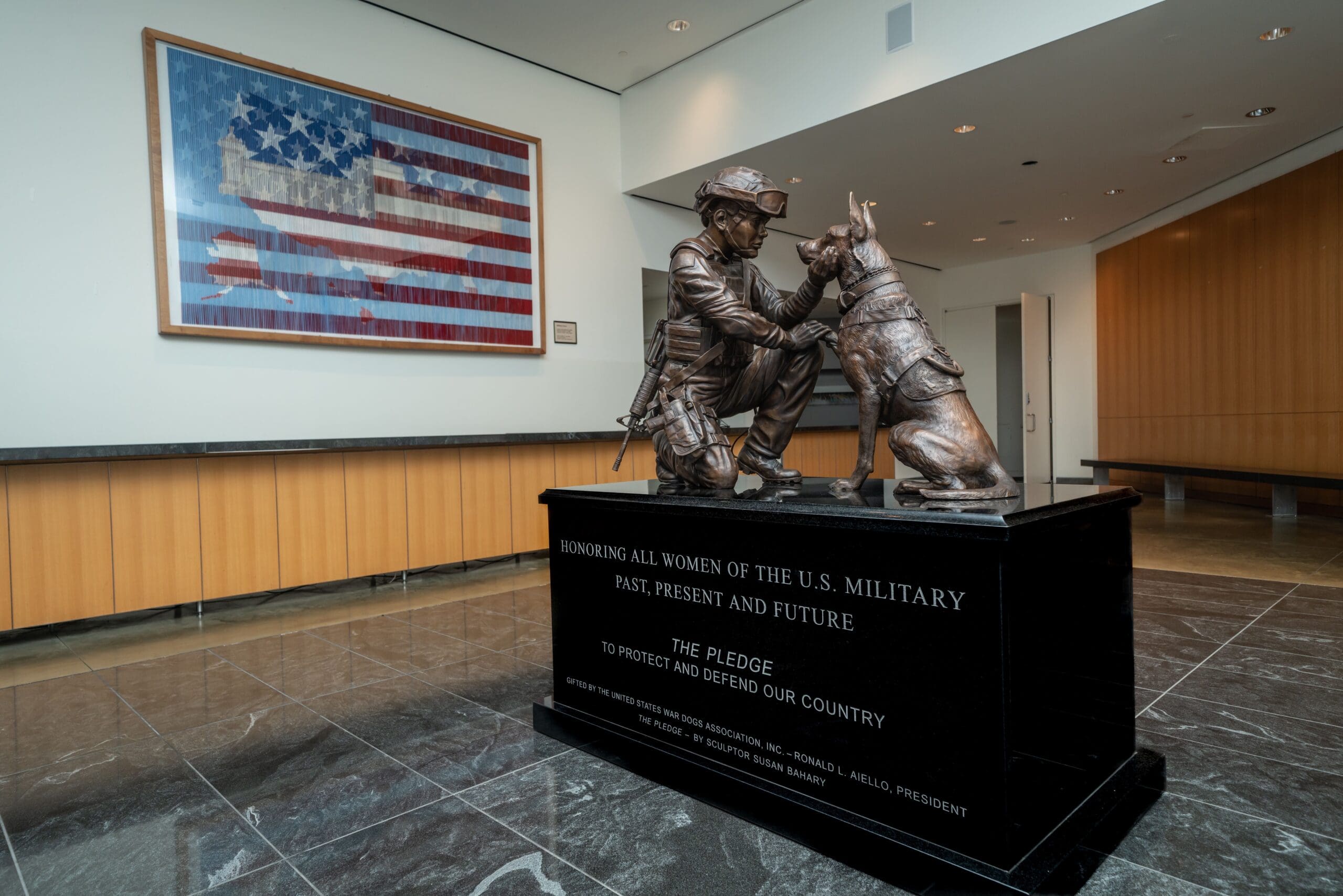
Like Johnson’s experience in Panama, Lavalle’s passion for dogs led her to join the military police corps in 2001 and later transition to a MWD handler in 2003.
“I think we have evolved when it comes to women serving in the MWD MOS,” Lavalle said, adding that more women should choose to serve as a 31K.
The Army currently has close to 650 Soldiers in the MWD field, with nearly 20% of them female, she said.
“We have made a tremendous amount of progress, but we are still facing various obstacles,” Lavalle said. “I have faith we will continue to overcome them and exceed the standards.”
Overall, the MWD career field is one of the best jobs the Army has to offer, she said.
“I can’t even explain how rewarding it is,” Lavalle said. “When you first get your MWD assigned to you and you start to build that bond — then you start to see that team concept.”
Developing trust
Building trust with a K-9 counterpart is a critical aspect of the career field, Johnson said, as she recalled one incident with her explosives detection dog named Fido that warned Soldiers of a possible danger.
While deployed to Iraq, Johnson and another MWD handler joined a quick reaction force to track down an escaped prisoner in a vast junkyard filled with decommissioned Iraqi military equipment and vehicles.
The junkyard spanned across several acres with multiple entry points, Johnson said. Leaders decided to split the handlers into smaller squads and enter the scrapyard on opposing sides to cover more ground.
“I am telling my dog, ‘Find the bad guy,’ as he almost pulls my arm out of the socket,” Johnson said. “We are moving through the junkyard when he starts going crazy and immediately sits down.”
Thinking Fido was just confused by her command, Johnson encouraged him to get back up and continue the search. He pressed forward a little further before deciding to sit once again.
That was when it dawned on her that she recognized her dog’s signal for unexploded ordinances in the area.
Military working dogs are trained to receive praise or reward after completing a task, Johnson explained. An MWD never stops working. In this instance, Fido made the right choice to signal instead of blindly searching the area for the escaped individual.
“I turned around to the squad leader and said, ‘Shut off all your radios, let my dog in front of you and only step where we step.’”
Johnson led the team out of the junkyard and ran around to extract the other squad. The second handler was paired with a narcotics detection dog and was not trained to detect explosives in the area.
“Establishing a bond and rapport is everything to that handler,” Lavalle said. “Without it, that team will not be effective” or could become a liability.
“That is something that we establish from day one when a Soldier goes through dog handling school,” she added. “Understanding the need for a common mutual respect between the dog and handler, and building the rapport and fundamentals during training” is critical to the mission.
The Pledge
Planning for the monument started just under two years ago after the U.S. War Dogs Association commissioned a memorial to honor the service and sacrifice of female MWD handlers, Bahary said.
“With ‘The Pledge,’ we felt it had to represent all women in the military,” Bahary said. “When you can move people emotionally through a work of art, it can open their hearts and make them more apt to learn.”
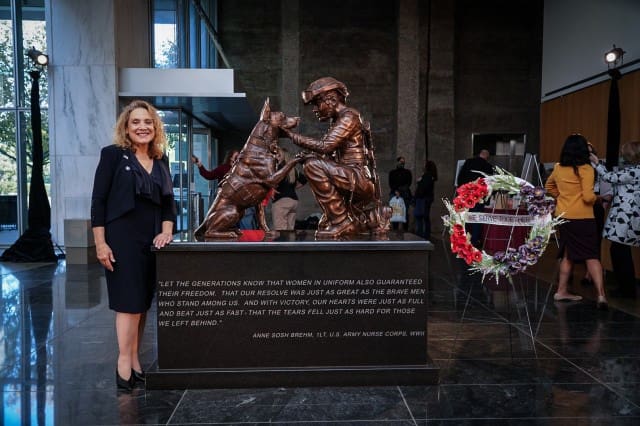
As Bahary started designing the monument, she was determined to convey a strong message of duty, capability, commitment and compassion in both figures. She began by looking at many photos of MWD handlers to draw inspiration for her design.
At one point in the design process, Bahary physically kneeled as if to pose herself in front of a dog sitting with an outstretched paw. Doing so helped ensure a level of authenticity in her final design, she said.
Bahary then went on to start the female figure using a metal armature as a base and covering it with layers upon layers of clay, she said. She then began the sculpting of the military working dog and later added the intricate details of the uniform and equipment.
The model was then cast to create a series of molds, she said. From these molds a multi-step process known as a lost-wax was used to produce a bronze casting of the final figure. The metal process can take two to three months to complete.
The final piece was welded together, the metal was finished, sprayed, and brushed with different chemicals and heated to create color variations. It was then mounted onto a granite base for display at the memorial.
Bahary created the country’s first official war dog memorial, “Always Faithful,” in 1994 to honor all military working dogs killed during service. It was unveiled at the Pentagon and dedicated at the Marine Corps War Dog Cemetery in Guam. It depicts the well-known Marine Corps Doberman named Kurt that fought during the Second Battle of Guam during World War II.
She is also working on the National Service Animals Monument. This monument will be dedicated to the deeds and sacrifices of all animals employed by the military, police, and search and rescue groups, along with the animals providing assistance and companion services or emotional support.
“As an artist, this is an incredible honor,” Bahary said. “It feels so gratifying to know that the women in the military are finally getting this kind of well-deserved recognition in our nation’s capital.”
The Pledge monument is genuinely humbling, Lavalle said, adding that Bahary did a phenomenal job representing all female handlers.
“It is an honor to have the opportunity to be the first female handler to achieve the rank of sergeant major, and to be a part of this era where women handlers are starting to be formally recognized and honored for their sacrifices and commitment to the military working dog program,” Lavalle said.
“As a 31K dog handler, it is my duty and the duty of other women handlers to continue to pave the way,” she added. “This is my passion, and I couldn’t see myself doing anything else. I was born to be a dog handler and trainer.”
By Devon Suits, Army News Service
Woof and Whiskers’ Small Travel Food Bag is now offered in 3 different sizes. They are made from 1000D Cordura with a pack cloth interior. The tops are closed with a YKK zipper and they incorporate a 2″ clear window.
Available in Coyote, Black and Grey.
These Made in the USA bags feature a 60-day trial and a lifetime guarantee.
Buy online at www.wwpetproducts.com
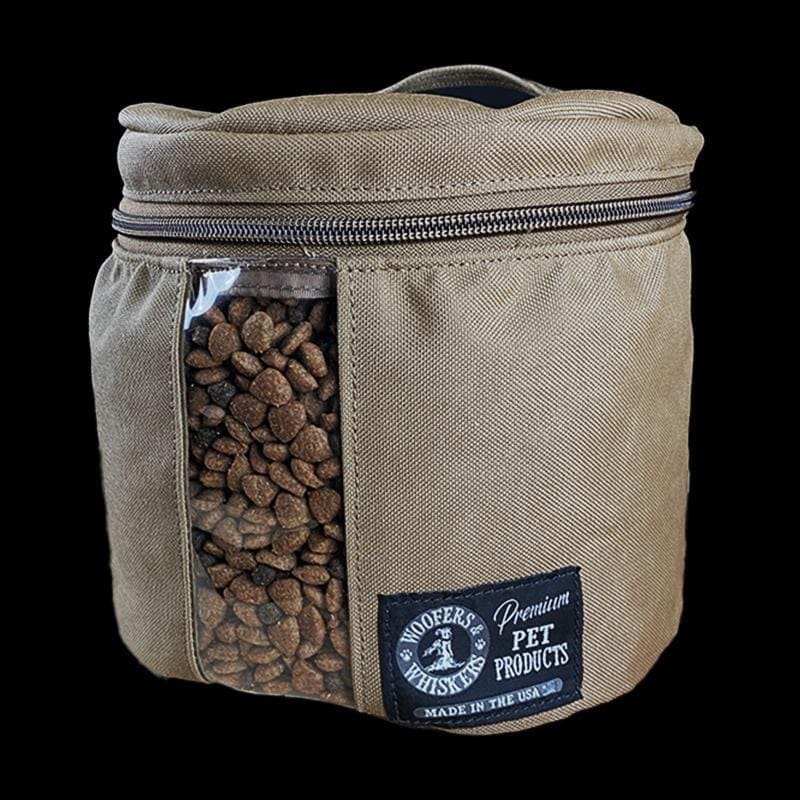
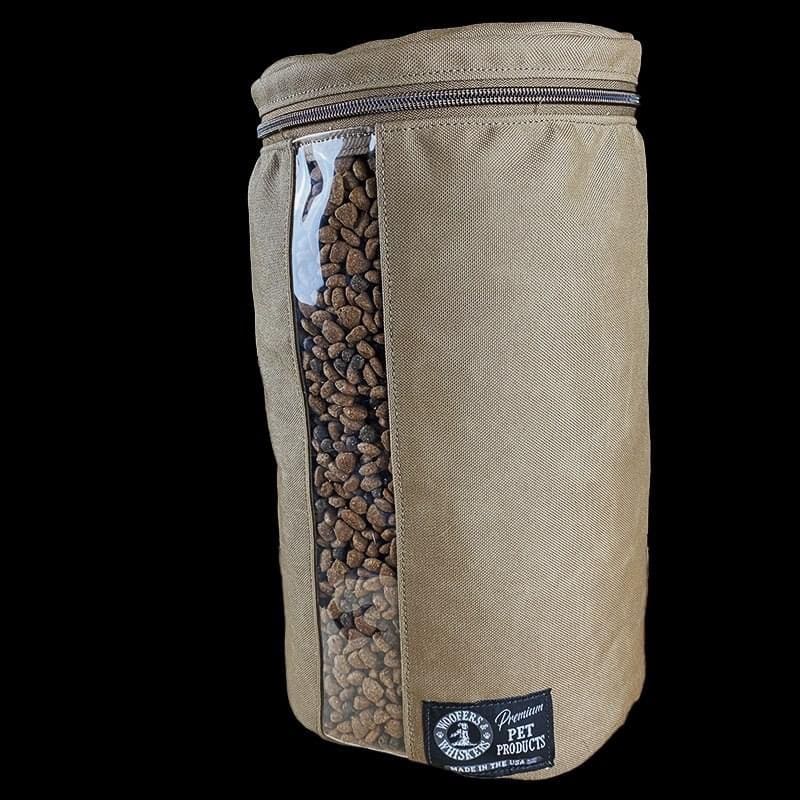


RESEARCH TRIANGLE PARK, N.C. — Military working dogs often scout areas for explosives devices and hazardous materials and assist in rescue operations, but giving dogs the necessary commands to perform these missions can put Soldiers in harm’s way. Augmented reality may change that.

Through a project funded by the Small Business Innovation Research program and managed by the Army Research Office, an element of the U.S. Army Combat Capabilities Development Command’s Army Research Laboratory, a new technology has been developed by Command Sight, Inc., to provide military working dogs with augmented reality goggles that allow a dog’s handler to give it specific directional commands while keeping the warfighter remote and out of sight.
In 2017, Dr. A.J. Peper started Command Sight, a small business based in Seattle, to bridge human and animal communication. Through conversations with current and former military operators he identified a need to increase the efficacy of communication between canine and handler. As a result, Command Sight built the first prototype of augmented reality glasses for military working dogs.
Peper said initial feedback from his proof of concept was, “the system could fundamentally change how military canines are deployed in the future.”
The augmented reality goggles are specially designed to fit each dog with a visual indictor that allows the dog to be directed to a specific spot and react to the visual cue in the goggles. The handler can see everything the dog sees to provide it commands through the glasses.
“Augmented reality works differently for dogs than for humans,” said Dr. Stephen Lee, an ARO senior scientist. “AR will be used to provide dogs with commands and cues; it’s not for the dog to interact with it like a human does. This new technology offers us a critical tool to better communicate with military working dogs.”

The initial prototype is wired, keeping the dog on a leash, but researchers are working to make it wireless in the next phase of development.
“We are still in the beginning research stages of applying this technology to dogs, but the results from our initial research are extremely promising,” Peper said. “Much of the research to date has been conducted with my rottweiler, Mater. His ability to generalize from other training to working through the AR goggles has been incredible. We still have a way to go from a basic science and development perspective before it will be ready for the wear and tear our military dogs will place on the units.”
The basic science research behind this technology focuses on understanding canine vision and cognition as this tool is developed.
“We will be able to probe canine perception and behavior in a new way with this tool,” Lee said.
Currently, military working dogs are commonly directed by hand signals, which require the handler to be within sight of the dog, or by laser pointers, which also required the handler to remain close to the dog and generates a light source, which could be a safety issue.
Audio communication, using a camera and a walkie talkie placed on the dog are also used to direct the canines and allows the handler to be further from the dog, but the verbal commands can lead to confusion for the dog, for example, a dog runs around a set of stairs rather than going up them.
Augmented reality goggles could offer Special Forces dogs and their handlers a new alternative.
“The military working dog community is very excited about the potential of this technology,” Lee said. “This technology really cuts new ground and opens up possibilities that we haven’t considered yet.”
The augmented reality system uses goggles military working dogs have already been wearing for protection in inclement conditions and aerial deployments from Rex Specs. By leveraging a product the dogs are already used to wearing, Peper said it makes the technology adoption easier for both the dogs and the handler.
“Even without the augmented reality, this technology provides one of the best camera systems for military working dogs,” Lee said. “Now, cameras are generally placed on a dog’s back, but by putting the camera in the goggles, the handler can see exactly what the dogs sees and it eliminates the bounce that comes from placing the camera on the dog’s back.”
The Command Sight team has completed the Phase I of the SBIR and was selected to continue to Phase II. The SBIR program funds research and technology development with small businesses using a three-phase process. In contrast to the basic research programs managed by ARO, the SBIR program focuses primarily on feasibility studies leading to prototype demonstration of technology for specific applications.
Additionally, the Department of Defense Rapid Reaction Technology Office has provided funding for the next phase of development. With that funding, Command Sight is now working with Navy Special Forces to build prototypes that will be tested on their military working dogs. Each of the dogs received a 3D scan to get dimensional data to understand where to place optics and electrical components, specific to each dog.
The researchers plan to spend the next two years developing a production level wireless product. Once they have a prototype they will get user feedback and revise the product for manufacturing.
“ARO has been a critical partner in making technical, training and direct user connections to build ground swell of interest and secure funding sources,” Peper said. “We’re excited about getting this into the hands of the Soldier, hopefully in just a few years.”
By US Army CCDC Army Research Laboratory Public Affairs

Good morning and Happy MATBOCK Monday!
The D-Lift or Dog Lift is a super lightweight stretcher designed for working dogs. It’s constructed with our waterproof Ghost Heavy material and kevlar thread making it easy to decontaminate and clean without degrading the material and thread. It can be used with the Kodiak Releasable Dog Leash to form a carrying strap for the handler or as a hoisting strap for helicopter operations.
Specifications:
Dimensions: 40.5″ x 24.5″
Weight: 5.8oz


Don’t forget to tune in on Monday at 1:00 PM EST as we go live to demo the D-Lift and answer your questions!
www.matbock.com/collections/dog-handler/products/d-lift